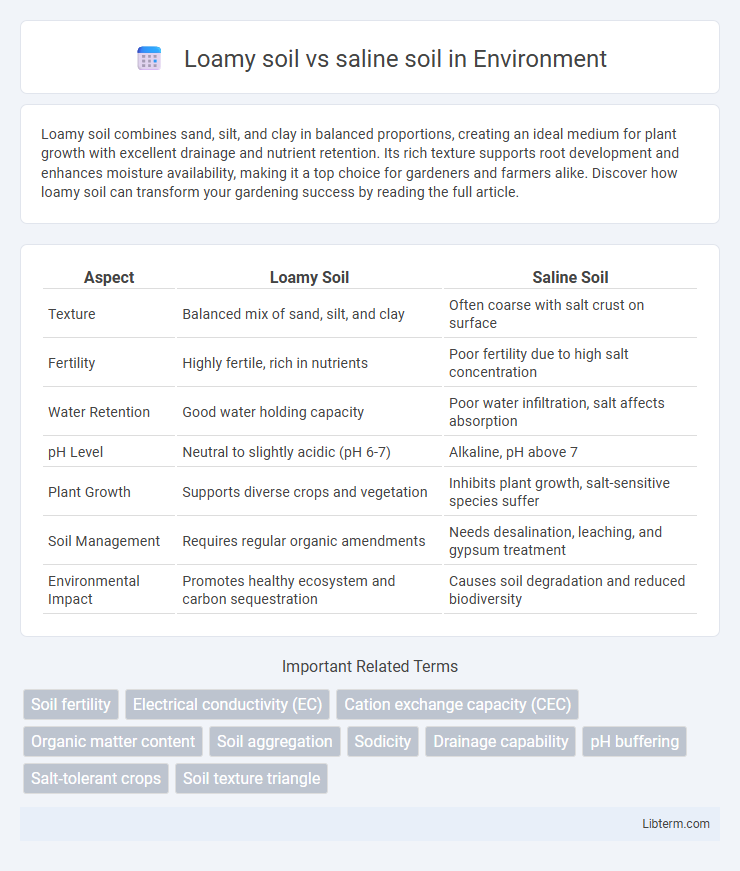Loamy soil combines sand, silt, and clay in balanced proportions, creating an ideal medium for plant growth with excellent drainage and nutrient retention. Its rich texture supports root development and enhances moisture availability, making it a top choice for gardeners and farmers alike. Discover how loamy soil can transform your gardening success by reading the full article.
Table of Comparison
| Aspect | Loamy Soil | Saline Soil |
|---|---|---|
| Texture | Balanced mix of sand, silt, and clay | Often coarse with salt crust on surface |
| Fertility | Highly fertile, rich in nutrients | Poor fertility due to high salt concentration |
| Water Retention | Good water holding capacity | Poor water infiltration, salt affects absorption |
| pH Level | Neutral to slightly acidic (pH 6-7) | Alkaline, pH above 7 |
| Plant Growth | Supports diverse crops and vegetation | Inhibits plant growth, salt-sensitive species suffer |
| Soil Management | Requires regular organic amendments | Needs desalination, leaching, and gypsum treatment |
| Environmental Impact | Promotes healthy ecosystem and carbon sequestration | Causes soil degradation and reduced biodiversity |
Introduction to Loamy and Saline Soils
Loamy soil, composed of balanced sand, silt, and clay particles, offers optimal drainage and nutrient retention, making it ideal for agriculture and plant growth. Saline soil contains high concentrations of soluble salts, which impair water absorption by plants and reduce crop yield. Understanding the physical and chemical properties of loamy and saline soils is crucial for effective soil management and sustainable farming practices.
Key Characteristics of Loamy Soil
Loamy soil is characterized by a balanced mixture of sand, silt, and clay, providing excellent drainage and nutrient retention crucial for plant growth. This fertile soil type boasts a soft texture, high organic matter content, and optimal aeration, supporting root development and microbial activity. Unlike saline soil, which contains high salt concentrations that hinder plant health, loamy soil maintains a neutral pH ideal for diverse agricultural uses.
Defining Features of Saline Soil
Saline soil is characterized by high concentrations of soluble salts, primarily sodium chloride, calcium sulfate, and magnesium sulfate, which inhibit plant growth and reduce soil fertility. Unlike loamy soil, known for its balanced texture and excellent drainage, saline soil exhibits poor structure, low permeability, and a white crust on the surface due to salt accumulation. High electrical conductivity (EC greater than 4 dS/m) is a key indicator of saline soil, distinguishing it from fertile loamy soil with moderate EC levels.
Soil Composition: Loamy vs Saline Soil
Loamy soil consists of balanced proportions of sand, silt, and clay, providing optimal aeration, drainage, and nutrient retention for plant growth. In contrast, saline soil contains high concentrations of soluble salts, primarily sodium chloride, which disrupts soil structure by causing clay dispersion and reducing permeability. The distinct compositions affect soil fertility, with loamy soil promoting healthy microbial activity while saline soil often leads to toxic conditions for most crops.
Water Retention and Drainage Differences
Loamy soil exhibits excellent water retention due to its balanced mixture of sand, silt, and clay, allowing roots to access moisture while maintaining proper aeration. In contrast, saline soil struggles with water retention because high salt concentrations create osmotic stress, reducing water availability to plants and often causing poor drainage. Efficient drainage in loamy soil prevents waterlogging, whereas saline soil's impaired drainage exacerbates salt accumulation, further hindering plant growth and water absorption.
Impact on Plant Growth and Crop Yield
Loamy soil offers optimal aeration, water retention, and nutrient availability, promoting robust root development and higher crop yields. Saline soil contains high concentrations of soluble salts, which disrupt water uptake by plants, leading to stunted growth, nutrient imbalances, and significantly reduced crop productivity. Managing soil salinity through proper irrigation and soil amendments is crucial for restoring plant health and improving agricultural output in affected areas.
Nutrient Availability in Both Soils
Loamy soil offers balanced nutrient availability due to its ideal texture, which promotes efficient water retention and aeration, facilitating optimal root absorption of essential minerals like nitrogen, phosphorus, and potassium. Saline soil, in contrast, exhibits reduced nutrient availability because high salt concentrations cause ion imbalances and osmotic stress, limiting plant uptake of critical nutrients and potentially leading to toxicity or deficiencies. Managing nutrient availability in saline soils requires practices like gypsum application and organic amendments to improve soil structure and reduce salt stress, enhancing nutrient uptake efficiency.
Soil Management Practices for Loamy and Saline Soils
Effective soil management for loamy soil involves maintaining its balanced texture by incorporating organic matter to enhance fertility and water retention, alongside regular crop rotation to prevent nutrient depletion. Saline soil management requires practices such as leaching with good-quality water to reduce salt concentration, application of gypsum to displace sodium ions, and improving drainage systems to prevent salt accumulation. Monitoring soil pH and electrical conductivity is crucial for both soil types to optimize nutrient availability and promote healthy plant growth.
Environmental Effects and Sustainability
Loamy soil supports sustainable agriculture by enhancing water retention, nutrient availability, and microbial activity, which promotes healthy plant growth and reduces erosion risks. Saline soil, characterized by high salt concentrations, impairs plant development, disrupts soil microbial ecosystems, and leads to land degradation, threatening long-term agricultural productivity and ecosystem balance. Effective management practices like proper irrigation and crop selection are essential to mitigate saline soil impacts and maintain environmental sustainability.
Choosing the Right Soil for Agriculture
Loamy soil, rich in sand, silt, and clay, provides excellent drainage, nutrient retention, and aeration, making it ideal for diverse crop cultivation. Saline soil contains high concentrations of soluble salts, which hinder plant growth by causing osmotic stress and nutrient imbalance. Selecting loamy soil over saline soil enhances agricultural productivity by supporting root development and optimal nutrient uptake.
Loamy soil Infographic

 libterm.com
libterm.com